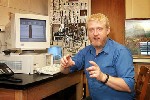 New research by a Wake Forest University psychologist may help cardiac patients experience less pain when their implanted cardioverter defibrillators (ICDs) shock their hearts back into a regular rhythm.
New research by a Wake Forest University psychologist may help cardiac patients experience less pain when their implanted cardioverter defibrillators (ICDs) shock their hearts back into a regular rhythm.
ICDs are the most effective treatment for many cardiac patients who suffer from life-threatening disturbances of heart rhythm, said Terry Blumenthal, associate professor of psychology at Wake Forest. But, when the devices activate, patients experience significant pain.
“The abrupt pain and the startle response caused by these shocks are important problems for patients with ICDs,” Blumenthal said. “The results of the study could provide a method for reducing the pain and improving patient acceptance of ICD therapy.”
In his study, published in the March/April issue of Psychosomatic Medicine, Blumenthal found that when a painless electrical pulse or “prepulse” precedes a painful electrical shock, it can significantly reduce the pain of the shock. The prepulse seems to lessen the startle response-the body’s reaction to a sudden event like a loud noise. This response interrupts whatever a person is doing or thinking about, and includes eye blinking or sometimes a whole-body jerk.
“A person’s response to a sudden sound, like a gunshot, can be reduced if the sound is preceded by a barely audible acoustic prepulse,” said Blumenthal, an expert on the startle response.
Based on this and other research on the startle response, he and his colleagues reasoned that weak electrical prepulses might have an effect similar to the acoustic prepulse, and reduce the body’s abrupt pain and startle response to intense electrical shocks.
To test this hypothesis, he delivered shocks to the upper arms of 20 volunteer participants. The shocks, which lasted one thousandth of a second, were about twice as painful as an intense static electricity shock. Some shocks were delivered alone and some were preceded by weak prepulses. The brain registers the prepulses, although the individual cannot actually feel them, Blumenthal said.
The volunteers rated the level of pain associated with the shock. They rated the shocks following the prepulse as less painful than those received without the prepulse. The actual intensity of the shock, 150 volts, did not change. The prepulse had the greatest pain-reducing effect with volunteers who rated the shocks without the prepulse as the most painful.
“For patients who are made uncomfortable by the life-saving shock of an ICD, this research may be a step in the direction of less pain,” Blumenthal said.
In addition to its potential practical application with ICDs, the study also provides new information about how the brain processes abrupt painful stimuli.
Blumenthal’s co-investigators were Traverse T. Burnett, a former Wake Forest graduate student, and Dr. Charles Swerdlow, a cardiologist at Cedars Sinai Medical Center in Los Angeles and an expert on ICDs. The study was funded by Imperception Inc. of Los Angeles.
Editors’ note: Blumenthal’s article can be found at www.psychosomatic.org
Categories: School of Medicine, University Announcement
Headlines
Wake Forest in the News
Wake Forest regularly appears in media outlets around the world.




